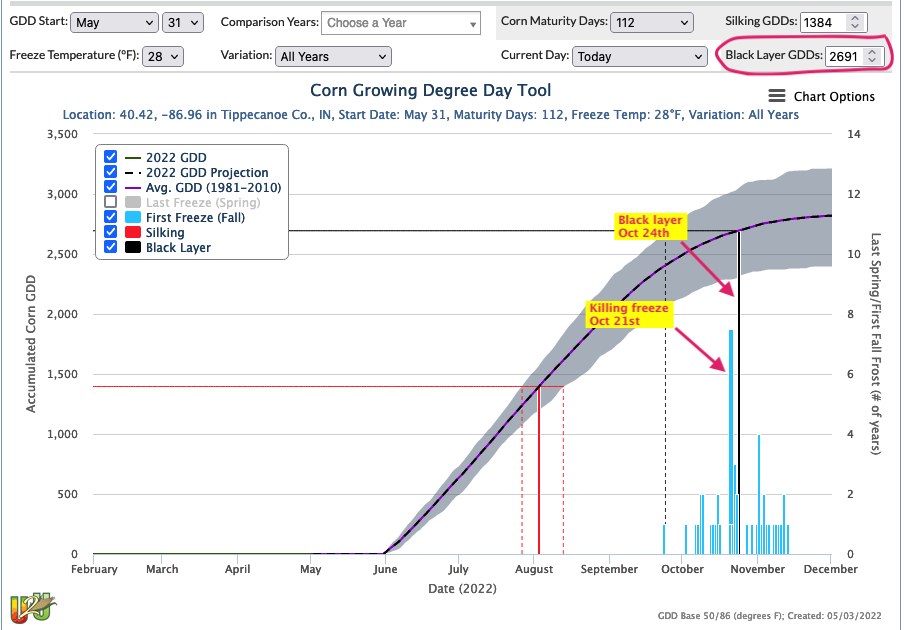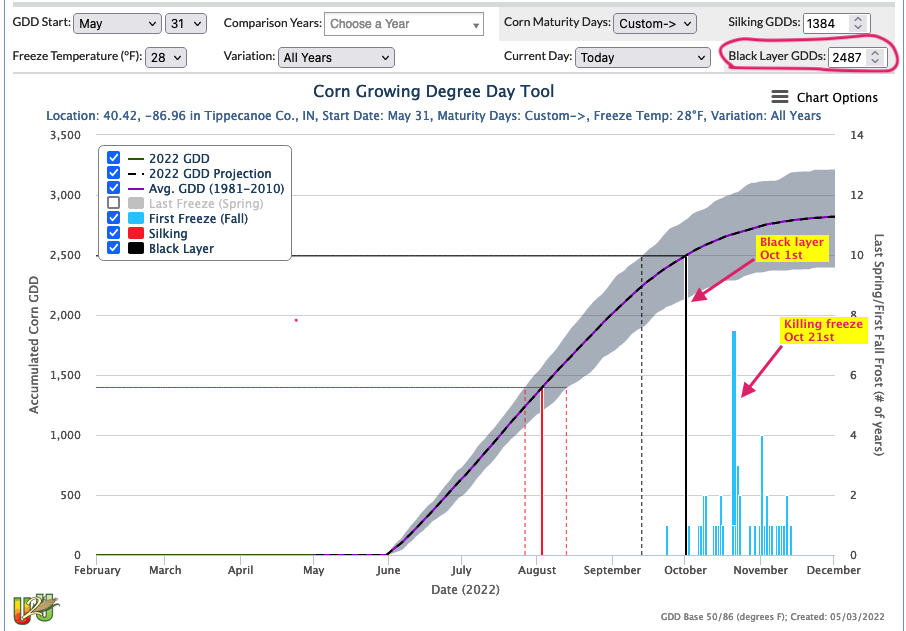Revised May 2022
URL: http://www.kingcorn.org/news/timeless/HybridMaturityDelayedPlant.html
Hybrid Maturity Decisions for Delayed Planting
R.L. (Bob) Nielsen
Agronomy Dept., Purdue Univ.
West Lafayette, IN 47907-2054
Email address: rnielsen at purdue.edu
Twitter: @PurdueCornGuy
Bottom Line
Delayed planting certainly shortens the growing season for corn, both in terms of calendar days but more importantly in terms of available GDDs for the plants to safely mature before a fall frost or killing freeze. The good news is because hybrids appear to decrease their GDD needs with delayed planting, one can plant adapted, full-season hybrid maturities later than otherwise expected. However, by about the last week of May, some growers in the central and, especially, northern parts of Indiana need to consider switching to earlier-maturity hybrids to minimize the risk of not maturing safely prior to a killing fall freeze. The steps outlined in this article will help growers and consultants determine "safe" hybrid maturities for late planting.
![]() elayed planting seasons create a lot of frustrations for everyone involved with planting crops. One of the agronomic questions that comes up when planting is seriously delayed is whether farmers should consider switching from their normal full-season maturity hybrids to shorter-maturity hybrids. The question is based, of course, on the perceived risk of the crop not reaching physiological maturity before a killing fall freeze and the yield losses that could result. A related, and economic, concern with delayed planting of normal full-maturity hybrids is the risk of high grain moisture contents at harvest and the resulting costs incurred by artificial drying of the grain or price discounts by buyers.
elayed planting seasons create a lot of frustrations for everyone involved with planting crops. One of the agronomic questions that comes up when planting is seriously delayed is whether farmers should consider switching from their normal full-season maturity hybrids to shorter-maturity hybrids. The question is based, of course, on the perceived risk of the crop not reaching physiological maturity before a killing fall freeze and the yield losses that could result. A related, and economic, concern with delayed planting of normal full-maturity hybrids is the risk of high grain moisture contents at harvest and the resulting costs incurred by artificial drying of the grain or price discounts by buyers.
The traditional "days to maturity" rating system for hybrids (Nielsen, 2012) does not literally refer to calendar time and so is not helpful in making decisions about switching to early-maturity hybrids with delayed planting. How fast a corn plant develops (i.e., moves through growth stages) is very dependent on temperature (warm = fast, cool = slow). The accumulation of heat on a daily basis can be quantified on the basis of calculated Growing Degree Days or GDDs (Nielsen, 2020). The relative maturity of a hybrid can be more reliably characterized by how many GDDs it requires from planting to physiological maturity (kernel black layer).
NOTE: Most seed companies publish "GDDs to Black Layer" ratings for the hybrids in their lineup, but sometimes do not clearly state whether the accumulated GDD values are "from planting" or "from emergence". The discussion and guidelines provided in this article assume "GDDs from planting". If your seed company rates their hybrids "from emergence", you need to add about 115 GDDs to the hybrid's rating to account for the GDDs required from planting to emergence.
Interestingly, it appears that hybrids mature in fewer GDDs than predicted when planted "late". Based on research we conducted some years ago (Nielsen et al., 2002), hybrids planted later than about May 1 mature approximately 6.8 fewer GDDs for every day of delay beyond May 1, through at least the 2nd week of June (the latest planting dates we evaluated in the research). For example, a hybrid rated at 2700 GDDs from planting to physiological maturity (kernel black layer) and planted on May 31 reaches physiological maturity in less than 2500 GDDs after planting (e.g., 2700 - (30 days x 6.8)).
The following simple calculator can be used to quickly estimate the adjusted GDD requirements of a hybrid in response to delayed planting. With that estimate in hand, you can then compare that value with an estimate of the GDDs available between the date you expect to plant and the end of the season using long-term climate data tools like the Corn GDD Tool described in the following paragraphs.
Use the U2U Corn GDD Tool to Identify "Safe" Hybrid Maturities for Late Planting
The USDA-NIFA funded Useful to Usable (U2U) multi-state research and Extension project developed a GDD decision support tool that is hosted by the Midwest Regional Climate Center at https://mygeohub.org/groups/u2u/purdue_gdd. The Corn GDD Tool estimates county-level GDD accumulations and corn development dates based on current and historical GDD data plus user-selected start dates, relative hybrid maturity ratings, GDDs to blacklayer, and freeze temperature threshold values. The estimates are displayed graphically and in tabular form, plus the results can be downloaded in a Comma Separated Value (.csv) formatted file for you to work with in your own spreadsheet program. The GDD Tool is currently applicable to the states of North Dakota, South Dakota, Nebraska, Kansas, Minnesota, Iowa, Missouri, Wisconsin, Illinois, Michigan, Indiana, Ohio, Kentucky, and Tennessee.
The choice of the date to represent the "end of the season" can be straight-forward or one of those "eyes of the beholder" decisions. If the main concern is to identify a "safe" hybrid maturity that will reach physiological maturity before a typical fall freeze date, then the steps described in this article are appropriate for you to follow. Some growers may opt to select an "end of season" date earlier than the historical first fall freeze date to ensure that physiological maturity will occur earlier during a time period that may allow for some grain drydown in the field and thus minimize their expenses of drying the grain artificially.
Corny Trivia: Frost often develops on exposed leaf surfaces at temperatures of 32F or slightly higher and can cause significant leaf injury or death, but the corn plant usually remains alive and capable of remobilizing non-structural carbohydrates from the stalk tissues to the immature grain. A temperature of 28F for several hours is considered lethal for corn plants.
Figure 1 below shows a screen capture from the Corn GDD Tool in which I selected "Tippecanoe Co., IN", a start date (aka planting date) of May 31, a relative hybrid maturity rating of 112 "days", and a freeze temperature threshold of 28F. The tool displays default values for GDDs to silking and black layer, but these can modified by the user. The graph depicts the estimates of silking and black layer dates for the 112-day hybrid planted on May 31, as well as the range of the estimates. When you are viewing the actual graph on the Web site, estimates of GDD accumulations at specific dates "pop up" when you hover your computer mouse over parts of the line graph.
The Corn GDD Tool does not currently account for the previously described phenomenon wherein corn hybrids typically mature in fewer GDDs than expected when planted later than May 1. In other words, the GDD Tool assumes the same GDDs to black layer for a given hybrid maturity whether planted April 20 or May 31. Consequently, you can be led astray by the Tool if you do not modify the "Black Layer GDDs" value in the Tool's input area. For example, the screen capture displayed in Fig. 1 for a 112-day hybrid with a default GDD rating of 2691 planted in Tippecanoe Co. on May 31 indicates the hybrid would mature on or about October 24, shortly after the average first killing 28F freeze. If, however, you manually change the expected "Black Layer GDD" value from 2691 to a more realistic 2487 GDDs (estimated using the calculator above), the GDD Tool then estimates the hybrid would safely mature by about October 1, well ahead of the usual killing fall freeze date (Fig. 2).
Final Considerations
- Availability of early-maturity hybrids with good yield potential, disease resistance (especially Gray leaf spot), and overall tolerance to stress may vary depending on seed company and location. Do not forget these important genetic characteristics when deciding whether to switch to earlier maturity hybrids in late planting situations.
- Some research suggests that yield decreases due to late planting are greater for full-season hybrids than for short-season hybrids (e.g., Jeschke and Paszkiewicz), whereas recently published research from Iowa documented very few differences among hybrid maturities in their relative rates of yield loss to delayed planting (Baum et al., 2019). This inconsistency for relative yield loss to delayed planting suggests growers should focus on whether particular hybrid maturities are expected to mature safely when planted late AND/OR whether expected differences in grain moisture content at harvest merit the decision to switch to earlier maturity hybrids in late planting situations.
- Most research indicates that optimum plant populations do not change as planting is delayed (Nielsen, 2019).
Figures

Fig. 1. Screen capture of U2U GDD Tool graphical display of historical and estimated future GDD accumulations and
predicted corn development stages for a 112-day hybrid planted May 31 in Tippecanoe County, IN.

Fig. 2. Screen capture of U2U GDD Tool graphical display of historical and estimated future GDD accumulations and
predicted corn development stages for a 112-day hybrid planted May 31 in Tippecanoe County, IN,
BUT WITH ITS GDD MATURITY REQUIREMENTS ADJUSTED FOR LATE PLANTING.
Related reading
Baum, M. E., S. V. Archontoulis, and M. A. Licht. 2019. Planting Date, Hybrid Maturity, and Weather Effects on Maize Yield and Crop Stage. Agron. J. 111:303-313. doi:10.2134/agronj2018.04.0297
Midwest Regional Climate Center. 2022. U2U Decision Support Tools - Corn GDD. Useful to Usable Project. https://mygeohub.org/groups/u2u/purdue_gdd [accessed May 2022].
Jeschke, Mark and Steve Paszkiewicz. [date unknown] Hybrid Maturity Switches Based on Long-Term Research. Pioneer (Corteva agriscience). https://www.pioneer.com/us/agronomy/hybrid_maturity_switches.html [accessed May 2022]
Nielsen, R.L. (Bob). 2012. Interpreting Corn Hybrid Maturity Ratings. Corny News Network, Purdue Univ. http://www.kingcorn.org/news/timeless/HybridMaturity.html [accessed May 2022].
Nielsen, R.L. (Bob). 2019. Optimum Plant Populations for Delayed Planting of Corn. Corny News Network, Purdue Univ. http://www.kingcorn.org/news/timeless/CornPltPopPltDate.html [accessed May 2022].
Nielsen, R.L. (Bob). 2020. Heat Unit Concepts Related to Corn Development. Corny News Network, Purdue Univ. http://www.kingcorn.org/news/timeless/HeatUnits.html [accessed May 2022].
Nielsen, R.L. (Bob). 2021. Grain Fill Stages in Corn. Corny News Network, Purdue Univ. http://www.kingcorn.org/news/timeless/GrainFill.html [accessed May 2022].
Nielsen, R.L. (Bob). 2022. The Planting Date Conundrum for Corn. Corny News Network, Purdue Univ. http://www.kingcorn.org/news/timeless/PltDateCornYld.html [accessed May 2022].
Nielsen, Robert L., Peter R. Thomison, Gregory A. Brown, Anthony L. Halter, Jason Wells, and Kirby L. Wuethrich. 2002. Delayed Planting Effects on Flowering and Grain Maturation of Dent Corn. Agron. J. 94:549-558.